Biography
Thirty years before the events in Close Quarters, and before going to London, he had attended a preparatory school of which he now remembers little except that the masters had seemed much happier than the boys. In the short story Modus Operandi we are told that he came to London from Norfolk at the age of 17, which would place his year of birth at 1890. He began by "pounding a beat in Whitechapel." The first time we see him in Close Quarters he is "a thick square man with a brick-red face" and unmarried. A few pages further, after he raises an imaginary gun to his shoulder and fires it, a character thinks that he looks like "a jolly red-faced farmer out for a day's sport". Besides smoking an occasional pipe or Indian cheroot, he has "a heavy jowl and shrewd grey eyes". We are told that he is a mountaineer, with a "fair head for heights". Sitting in his office in Scotland Yard several years later, just after the war, he has a "heavy, Cromwellian face". And in his last appearance in a novel he is:
unmistakably a policeman, although he could also have been a farmer. He was thick set and had a red-brown face and grizzled hair.... Perhaps the only remarkable thing about him was his eyes. They were that shallow grey which, like the grey of the North Sea, can change without warning from friendliness to bleak wrath.
Also in Close Quarters we are told that of his many policeman-like qualities the chief one was "Concentration. Tireless, relentless, implacable concentration.... And yet something more than that. Selective concentration." In Modus Operandi we are told that "his chief asset is that he looks so honest that no one ever attempts to bribe him" and that he has a "shrewd ability to see around corners, which came from his father, who was a poacher." And he has, of course, "a rigid sense of right and wrong."
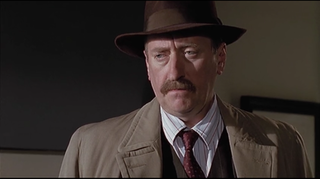
Inspector James Japp is a fictional character who appears in several of Agatha Christie's novels featuring Hercule Poirot.
Michael Francis Gilbert was an English solicitor and author of crime fiction.

Claud Eustace Teal is a fictional character who made many appearances in a series of novels, novellas and short stories by Leslie Charteris featuring The Saint, starting in 1929. A common spelling variation of his first name in reference works and websites is Claude, however in his works Charteris uses the spelling without the 'e'.

Unnatural Exposure is a crime fiction novel by Patricia Cornwell. It is the eighth book in the Dr. Kay Scarpetta series. The story is set in Richmond, Virginia and Ireland.

Charles Frederick Field was a British police officer with Scotland Yard and, following his retirement, a private detective. Field is perhaps best known as the basis for Inspector Bucket in Charles Dickens's novel Bleak House.
Patrick Petrella is a fictional police detective created by the British mystery writer Michael Gilbert who appears in ten books published between 1959 and 2003 and is probably the best-known of the half-dozen or so recurring characters that Gilbert wrote about throughout his long career. He is the protagonist of two novels and of 54 short stories that were first published in magazines and newspapers and then republished in eight collections of stories. In one of the short stories, however, "The Spoilers", in Game Without Rules, featuring Mr. Calder and Mr. Behrens as the protagonists, he appears only very briefly, at the end of the story. In his first appearance in a novel, the 1959 police procedural Blood and Judgement, Petrella is a "probationary" Detective Sergeant at the (fictional) Q Division of the London Metropolitan Police. By the final novel in the series, Roller Coaster, he has worked his way up to become a Superintendent.

Smallbone Deceased is a 1950 mystery novel by the English author Michael Gilbert, published in the United Kingdom by Hodder and Stoughton and in the United States by Harper & Brothers. A practising lawyer himself, Gilbert made the setting of the novel a London solicitor's office. The book was Gilbert's fourth novel and, like his three earlier ones, features Chief Inspector Hazlerigg. The novel was well-received and has regularly appeared in "Top 100" crime lists. Some critics consider it to be Gilbert's best work.

Close Quarters is the first novel by the British mystery writer Michael Gilbert. Published in England by Hodder and Stoughton in 1947, it did not appear in the United States until 1963. By then Gilbert's reputation had been firmly established in both countries and his regular American publisher for many years had been Harper & Brothers. Close Quarters, however, was published by Walker and Company, a less prestigious house. In it we are introduced to Chief Inspector Hazlerigg, who will go on to be a recurring character in a number of Gilbert's works throughout the next ten years. Gilbert, who was appointed CBE in 1980, was a founder-member of the British Crime Writers' Association. The Mystery Writers of America named him a Grand Master in 1988 and in 1990 he was presented Bouchercon's Lifetime Achievement Award.

Fear to Tread is a mystery–crime thriller by the British mystery writer Michael Gilbert, first published in 1953 by Hodder and Stoughton in England and by Harper & Brothers in the United States. Set mostly in London, it was his seventh novel in six years and built upon the favourable reputation he had achieved earlier with the well-received Smallbone Deceased and Death Has Deep Roots. Gilbert, who was appointed CBE in 1980, was a founder-member of the British Crime Writers' Association. The Mystery Writers of America named him a Grand Master in 1988 and in 1990 he was presented Bouchercon's Lifetime Achievement Award. It is one of numerous stories and novels by Gilbert presenting a gritty, realistic depiction of organized gangs, frequently directed by a deeply concealed mastermind who is not unearthed until the final pages.

Stay of Execution is a collection of mystery stories by the British thriller writer Michael Gilbert, first published in 1971 by Hodder & Stoughton. Gilbert, who was appointed CBE in 1980, was a founder-member of the British Crime Writers' Association. The Mystery Writers of America named him a Grand Master in 1988 and in 1990 he was presented Bouchercon's Lifetime Achievement Award. Unusually for a collection of stories, its reprint edition by House of Stratus in 2011 has no index detailing the stories in the book. The longest story, by far, is the last one in the book, Stay of Execution. At 54 pages, it is what is generally called a novella. Two of the stories feature Chief Superintendent Hazlerigg; three Henry Bohun; and one Detective Inspector Petrella, characters who have figured in other short stories and novels by Gilbert. The Independent said of the book in 2006:
Gilbert had a fondness for amusing but unscrupulous pirates... and an entirely practical, indeed sceptical, view of the workings of the law. It was typical of his humour that the two stories in his excellent collection Stay of Execution (1971) in which rascally solicitors "get away with it", "Back on the Shelf" and "Mr Portway's Practice", were written in the first person.
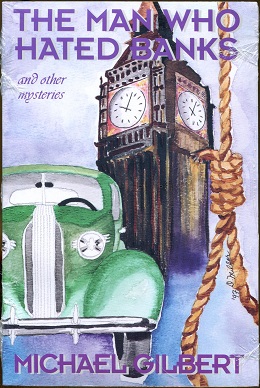
The Man Who Hated Banks is a collection of mystery stories by the British thriller writer Michael Gilbert, first published in 1997 by the American company Crippen & Landru. As the back cover of the book tells us, it was "published in honour of the fiftieth anniversary of Michael Gilbert's first book." Gilbert, who was appointed CBE in 1980, was a founder-member of the British Crime Writers' Association. The Mystery Writers of America named him a Grand Master in 1988 and in 1990 he was presented Bouchercon's Lifetime Achievement Award. It has an Introduction by the author and contains 18 of his previously uncollected stories, all of them concerning characters who have figured in other novels and short stories. Seven of the stories feature Chief Inspector Hazlerigg; five Henry Bohun; three Detective Chief Inspector Mercer; and three Detective Inspector Petrella.

Amateur in Violence is a collection of mystery stories by the prominent British thriller writer Michael Gilbert, published in the United States in 1973 by Davis Publications, a publishing house for magazines, but not in England. Gilbert, who was appointed CBE in 1980, was a founder-member of the British Crime Writers' Association. The Mystery Writers of America named him a Grand Master in 1988 and in 1990 he was presented Bouchercon's Lifetime Achievement Award. The book is edited, and has an introduction, by Ellery Queen, the founder and long-term editor of Ellery Queen's Mystery Magazine. It contains 10 stories and a short novel that had been previously uncollected in the United States. Some of them feature characters who have figured in other novels and short stories by Gilbert. Three stories feature Inspector Hazlerigg and four Inspector Petrella. The short novel, "Stay of Execution", had previously given its name to the title of a collection published in England in 1971. The title story was adapted into the 1960 film The Unstoppable Man.

The Curious Conspiracy is a collection of mystery stories by the British thriller writer Michael Gilbert, first published in 2002 by the American company Crippen & Landru and then in England. Published to recognize Gilbert's 90th birthday, it contains 20 previously uncollected stories, as well as a brief introduction by Gilbert himself and an appendix for Sources. Gilbert, who was appointed CBE in 1980, was a founder-member of the British Crime Writers' Association. The Mystery Writers of America named him a Grand Master in 1988 and in 1990 he was presented Bouchercon's Lifetime Achievement Award. Four of the stories in this collection feature two of Gilbert's many recurring characters that he created throughout his long career of writing both novels and short stories. Gilbert's introduction says that the topics covered by the stories are "catholic", in the sense of being "of universal human interest; touching the needs, interests or sympathies of all men." The locales vary from London to a Red Sea sheikdom and the time frame from the present day back to the Peninsular War. Some of them, such as "Judith", have an unexpected grimness about them. "Michael was an exceptionally fine storyteller, but he's hard to classify," said one of his British publishers after his death. "He's not a hard-boiled writer in the classic sense, but there is a hard edge to him, a feeling within his work that not all of society is rational, that virtue is not always rewarded.".
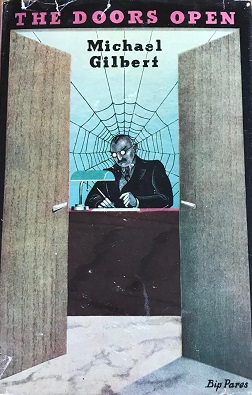
The Doors Open, published by Hodder and Stoughton in England in 1949 and by Walker and Company in the United States in 1962, is the third novel by the British mystery and thriller writer Michael Gilbert. Gilbert, who was appointed CBE in 1980, was a founder-member of the British Crime Writers' Association. The Mystery Writers of America named him a Grand Master in 1988 and in 1990 he was presented Bouchercon's Lifetime Achievement Award. Like his first two books, it features Inspector Hazlerigg, although not in a major role. It is, in fact, a very diffuse book in terms of its characters. Angus McMann, who was the chief protagonist of Gilbert's previous book, They Never Looked Inside, is briefly mentioned on the first page and makes a later appearance as a minor character. Hazlerigg does not appear until page 24 and thereafter only at intervals throughout the book. There are, in actuality, three other protagonists who, along with Hazlerigg, share the role of driving the narrative. One is Noel Anthony Pontarlier Rumbold ("Nap"), a junior solicitor in his father's London firm. Nap had spent four months on dangerous missions with the French maquis in occupied France during the war and is, apparently, still a Lieutenant-Colonel, D.S.O. A few years later he will be a main character in Gilbert's well-received novel Death Has Deep Roots. Patrick (Paddy) Yeatman-Carter, an acquaintance of Nap's, is another lead character, as is his uncle, Alfred Lord Cedarbrook, a man with an astonishing background, much sought after by both the Foreign Office and the War Office during WWII and now, apparently, still affiliated with the Secret Service. As well as being a linguist, explorer, soldier, and diplomat, he also has a law degree. All three of them, to one degree or another, carry out private investigations, sometimes with the backing of Hazlerigg, sometimes not.
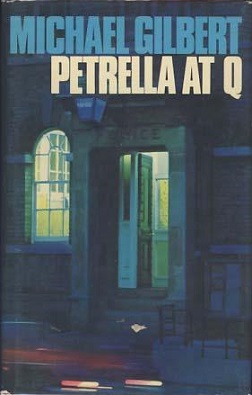
Petrella at Q is a collection of 11 short stories plus one longer story divided into four parts about the British policeman Patrick Petrella by the British writer Michael Gilbert published in the United Kingdom by Hodder and Stoughton in 1977 and in the United States by Harper & Row the same year. Gilbert, who was appointed CBE in 1980, was a founder-member of the British Crime Writers' Association. The Mystery Writers of America named him a Grand Master in 1988 and in 1990 he was presented Bouchercon's Lifetime Achievement Award. Many of the stories had previously appeared in such magazines as Reveille in the United Kingdom and Ellery Queen's Mystery Magazine in the United States. In addition to the stories themselves, there is an introductory sketch of Petrella by Gilbert written especially for this book. A second collection of stories, Young Petrella, was published ten years later, in 1987, but consisted exclusively of stories about Petrella's very first years on the force, when he began as a detective constable.

Young Petrella is a collection of 16 short stories about the British policeman Patrick Petrella by the British writer Michael Gilbert published in the United Kingdom by Hodder and Stoughton in 1987 and in the United States by Harper & Row the same year.

Even Murderers Take Holidays and Other Mysteries is a collection of mystery stories by British thriller writer Michael Gilbert, first published in 2007 by the British company Robert Hale and unpublished in the United States. It contains 25 previously uncollected stories, as well as an introduction by John Cooper and an appendix. The first twelve stories feature Inspector Petrella, one of the many recurring characters that Gilbert created throughout his long career of writing both novels and short stories. Its next story has Mr. Calder and Mr. Behrens, and there are four stories about Inspector Hazlerigg. Gilbert, who was appointed CBE in 1980, was a founder-member of the British Crime Writers' Association. The Mystery Writers of America named him a Grand Master in 1988 and in 1990 he was presented Bouchercon's Lifetime Achievement Award. The locales are mostly set in London and its environs. A number of the stories, such as "Somebody" and "Old Mr Martin", have an unexpected grimness about them. "Michael was an exceptionally fine storyteller, but he's hard to classify," said one of his American publishers after his death. "He's not a hard-boiled writer in the classic sense, but there is a hard edge to him, a feeling within his work that not all of society is rational, that virtue is not always rewarded."
Chief Superintendent Morrissey is a fictional policeman at New Scotland Yard who appears, or is at least mentioned in passing, in a number of short stories and two novels by the British mystery and thriller writer Michael Gilbert. In the 1972 The Body of a Girl, he is the CID boss of No. 1 District, "a large, white-faced Cockney Jew" with a grin that "exposed two gold-capped teeth." He also features in Gilbert's End-Game (1982). In the Inspector Mercer story "The Man in the Middle" he plays a minor role. Here he is described as "more than two hundred pounds of fighting policeman, still as formidable as when he had climbed into the ring to win the heavyweight championship of the Metropolitan Force." In the follow-up story, "The Man at the Top", Morrissey plays a much more important role, and the criminal mastermind, Mr. Henderson, says admiringly of him:
He used to be the CID head of Number 1 District. Now I hear he's in charge of the Metropolitan section of the Special Crimes Squads. Ten years ago I watched him boxing in the police heavyweight finals. He didn't just knock his man down....He knocked him clean out of the ring"
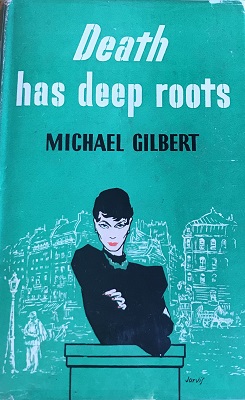
Death Has Deep Roots is the fifth novel by the British mystery writer Michael Gilbert. It was published in England by Hodder and Stoughton in 1951 and in the United States by Harper & Brothers in 1952. It is a classical courtroom trial story juxtaposed with thriller elements. Although Inspector Hazlerigg, who had appeared in all of Gilbert's earlier novels as a mostly leading character, does play a role in this story, it is only in two brief appearances, once towards the beginning of the book and once again near the end. Two of the three main characters in this book are from previous novels, Major Angus McMann and Noel Anthony Pontarlier ("Nap") Rumbold. The other leading character, the trial barrister Hargest Macrae, also appears in some of Gilbert's early short stories.
Inspector Bill Mercer is a detective created by the British crime and mystery writer Michael Gilbert. He is the leading character in the 1972 novel The Body of a Girl, a somewhat hardboiled police procedural, and appears later in at least three short stories. On the first page of the novel, "Detective Inspector William Mercer received... confirmation of his promotion to chief inspector and his appointment in charge of the CID at Stoneferry on Thames, which is one of the larger upriver stations of Q Division of the Metropolitan Police."















